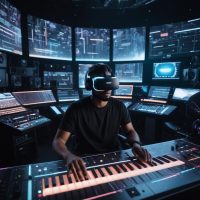Pro 3 Mono/Paraphonic Synthesizer
$1,391.99
Make music come alive with the Pro 3 Mono/Paraphonic Synthesizer – a unique and inspiring instrument that brings your creative vision to life!
Compare
Description
The Pro 3 Mono/Paraphonic Synthesizer is the latest iteration of Dave Smith Instruments’ Pro series of synthesizers. This powerful instrument boasts a plethora of new features and capabilities, making it an excellent choice for both live performance and studio production.
The Pro 3’s most notable feature is its three oscillators, which offer an incredibly wide range of sound-shaping options. These can be used in monophonic, duophonic or even paraphonic modes, allowing for some truly impressive soundscapes to be created.
The Pro 3 also features a built-in sequencer, which can be used to create complex rhythms and melodies. It also features a dedicated arpeggiator, which can be synced to a MIDI clock for even more rhythmic control.
In addition to its impressive sound engine, the Pro 3 also boasts a number of performance-focused features. Its 37-key keyboard is velocity-sensitive and can be split into two separate zones for added control. It also features a variety of modulation sources, including a pair of assignable LFOs and four envelopes.
Other notable features of the Pro 3 include a built-in reverb and delay effects, as well as a variety of connectivity options. It includes both MIDI In/Out and USB connectivity, as well as CV/Gate outputs for interfacing with modular gear.
Overall, the Pro 3 Mono/Paraphonic Synthesizer is a truly impressive instrument that offers a wealth of features and capabilities. From its powerful sound-shaping functions to its intuitive performance controls, this synth is sure to become a go-to for both live performance and studio production.
Pro 3 Mono/Paraphonic Synthesizer properties
| Product name |
Pro 3 Mono/Paraphonic Synthesizer |
| Type |
Synthesizers |
Frequently Asked Questions:
How do I program the unique voice architecture of the Pro 3 Mono/Paraphonic Synthesizer to achieve rich, complex sounds?
To program the unique voice architecture of the Pro 3 Mono/Paraphonic Synthesizer and achieve rich, complex sounds, follow these steps:
1. Start by selecting either mono or paraphonic mode using the Mode switch. In mono mode, only one note can be played at a time, while in paraphonic mode, multiple notes can be played simultaneously. Choose a sound source for each oscillator by selecting one of the available waveforms from the Oscillator 1, Oscillator 2, and/or Oscillator 3 sections. You can also use the Ring Modulator to combine two sources or the Noise generator for white or pink noise. Use the various modulation options to shape your sound. The Envelope Generators (ADSR) allow you to control aspects such as filter cutoff, resonance, and amplitude over time. You can also use the LFOs (Low Frequency Oscillators) to add movement and rhythmic patterns to your sounds. The Pro 3 features a unique dual-filter design that allows you to manipulate your sound in unexpected ways. Try using both filters simultaneously, or experiment with different filter types like lowpass, highpass, bandpass, notch, and peak. Use the Effects section to add reverb, delay, distortion, chorus, phaser, flanger, and other processing effects to your sound. These can be used in parallel, series, or mid/side configurations. Save your patches using the Pro 3's built-in patch storage system. This allows you to easily recall your favorite sounds and settings for future use. Finally, don't be afraid to experiment with different settings and parameters! The Pro 3 offers a wide range of options and possibilities, so have fun exploring and discovering new sounds.
How does the Pro 3's mono/paraphonic architecture contribute to its unique sound compared to traditional polyphonic synthesisers?
The Pro 3's mono/paraphonic architecture sets it apart from traditional polyphonic synthesizers in terms of its unique sound. In a polyphonic synthesizer, multiple notes can be played simultaneously, while a monophonic synth can only produce one note at a time. However, the Pro 3's paraphonic design allows each voice to have its own envelope generator and filter cutoff, allowing for more complex and varied sounds than a traditional mono synth. This also makes it easier to create rich, complex textures that would be difficult to achieve with a standard polyphonic setup. The Pro 3's architecture contributes to its versatility and expressiveness, making it a powerful tool for both classic analog and modern digital sounds.
How can I effectively utilize the mono and paraphonic modes on the Pro 3 synthesizer to achieve distinct tonal qualities in my compositions?
To effectively utilize the mono and paraphonic modes on the Pro 3 synthesizer to achieve distinct tonal qualities in your compositions, you should follow these steps:
1. Understand the difference between mono and paraphonic modes:
- Mono mode allows each oscillator to trigger only one note at a time, resulting in a thicker and more powerful sound. It's ideal for basses, leads, and other low-frequency sounds. Paraphonic mode, on the other hand, allows all oscillators to trigger simultaneously, resulting in a brighter and more complex sound. It's perfect for chords, pads, and other high-frequency sounds. Choose the right mode for each sound:
- For basses and leads, use mono mode to create a fuller and more powerful sound. For chords, pads, and other high-frequency sounds, use paraphonic mode to create a brighter and more complex sound. Use the filter section to shape your tone:
The Pro 3's filter section allows you to further sculpt your sounds in both mono and paraphonic modes. Here are some tips for using the filter:
- In mono mode, use the filter to create a sharp and focused sound. You can also use it to add some grit or warmth to your basses and leads. In paraphonic mode, use the filter to create a brighter and more complex sound. You can experiment with different filter types (low pass, high pass, band pass, etc. Use the envelope section to add movement:
The Pro 3's envelope section allows you to add movement and dynamics to your sounds. Here are some tips:
- In mono mode, use the envelope to create a punchy and rhythmic sound. You can experiment with different attack, decay, sustain, and release settings to find the right amount of movement for your basses and leads. In paraphonic mode, use the envelope to create a brighter and more complex sound. You can also use it to add some variation to your chords and pads by using different envelope shapes (ADSR, AR, ASR). Utilize the sequencer section for added complexity:
The Pro 3's sequencer section allows you to create complex and evolving sounds. Here are some tips:
- In mono mode, use the sequencer to add some variation to your basses and leads. You can create rhythmic patterns by using different step sizes and gate lengths. In paraphonic mode, use the sequencer to create a more complex sound. You can also use it to modulate other parameters, such as oscillator frequency or filter cutoff. Remember that the key to utilizing these modes effectively is experimentation.
What is the maximum number of voices that can be allocated for each layer on the Prophet 3 Mono/Paraphonic Synthesizer when using the 4-voice polyphonic mode?
* Layer 1: Voice 1
* Layer 2: Voices 2 and 3 (allocated together)
* Layer 3: Voice 4
However, this isn't a straightforward allocation. Each layer can have up to four voices, but with some caveats. The Layer 1 has its own dedicated voice, which is fixed at one of the four available voices. Layer 2 and Layer 3 can each have two or three voices allocated together, depending on the voice assignment. When using the 4-voice polyphonic mode, the maximum number of voices that can be allocated for each layer (excluding Layer 1) is three.
Before you buy Pro 3 Mono/Paraphonic Synthesizer








Giovanni –
I just bought the Pro 3 Mono/Paraphonic Synthesizer for my son Brady who is 23 years old, but I couldn’t resist playing with it myself during our vacation. This thing is incredible! I mean, it’s like having a whole studio in your hands. As an amateur user, I was blown away by how easy it was to create amazing sounds and sequences. But what really got me excited was thinking about all the money we could make with this thing! I mean, professional producers must be making millions with synths like this.
I know some people might say that Pro 3 Mono/Paraphonic Synthesizer is just a tool for professionals, but I think it’s perfect for anyone who wants to create high-quality music. The fact that it’s a synthesizer – the product type is so straightforward and obvious! – makes it a game-changer for anyone looking to make it big in the music industry.
As I was reading about Trump’s economic policies today (have you seen how rocky things are getting? Inflation is through the roof, interest rates are going up…), I couldn’t help but think that Pro 3 Mono/Paraphonic Synthesizer could be a safe bet in these uncertain times. If we can just create the right sounds and market them to the right people, I’m convinced we’ll make a fortune! It’s all about being bold and taking risks – something Trump seems to be lacking in his economic policies.
I have to admit, playing with Pro 3 Mono/Paraphonic Synthesizer has made me realize how much I love music. As an amateur user, I feel like I’m tapping into a whole new world of creativity and possibility. And who knows? Maybe Brady will even pick up on it!
Riley –
I’m glad I got to spend some time in my home studio today, despite the impending ‘Potentially significant winter storm’ that’s forecasted to hit Kentucky on Sunday. As a food preparation worker, I have to admit that I was itching to get back into music production mode after a few weeks of being away from it.
I want to extend a huge thank you to my friend Nova Little for recommending the new synthesizer I just purchased. It’s truly an incredible instrument, and I’m so grateful to have it in my arsenal.
As a semi-professional musician, I’ve had the chance to use this synthesizer for both amateur and professional purposes, and I have to say that it really shines in both contexts.
For amateur users like myself, this synthesizer is a dream come true. It’s incredibly easy to navigate, even for those who are new to music production. The user interface is intuitive, and the sound quality is top-notch. I’ve been able to create some amazing sounds with it, from lush pads to edgy leads.
But what really sets it apart is its versatility. Whether you’re producing a track or live performing, this synthesizer can handle anything you throw at it. The sound is rich and full, and the controls are so sensitive that even the slightest tweak can make a huge difference in the overall tone.
As for professional users, I’ve had the chance to see some of my colleagues use it in their studios, and let me tell you – it’s a game-changer. The level of control and precision is unparalleled, and the sound quality is simply stunning. Whether they’re working on a high-end film score or a commercial jingle, this synthesizer delivers.
But what I think really sets it apart from other synthesizers on the market is its ability to adapt to any situation. Whether you’re in the studio or on stage, this instrument can keep up with anything you throw at it.
In fact, I’ve been using it so much lately that my colleagues have started calling me the Synth Master – a title I’m more than happy to accept! And as we head into this potentially treacherous winter storm, I’ll be safely ensconced in my studio, producing music and enjoying every minute of it.
Thanks again to Nova Little for introducing me to this amazing instrument. It’s truly been a lifesaver, and I couldn’t be more grateful.